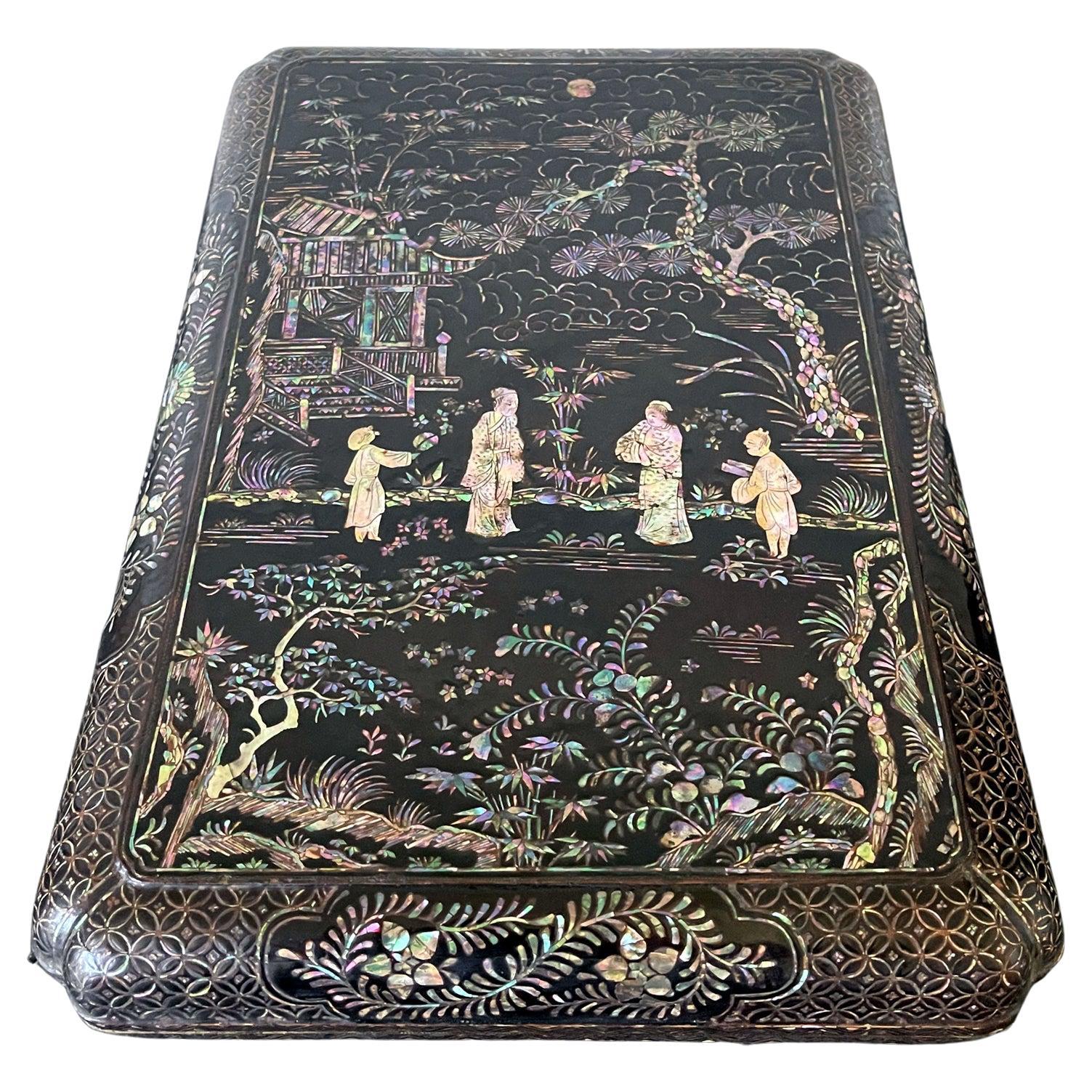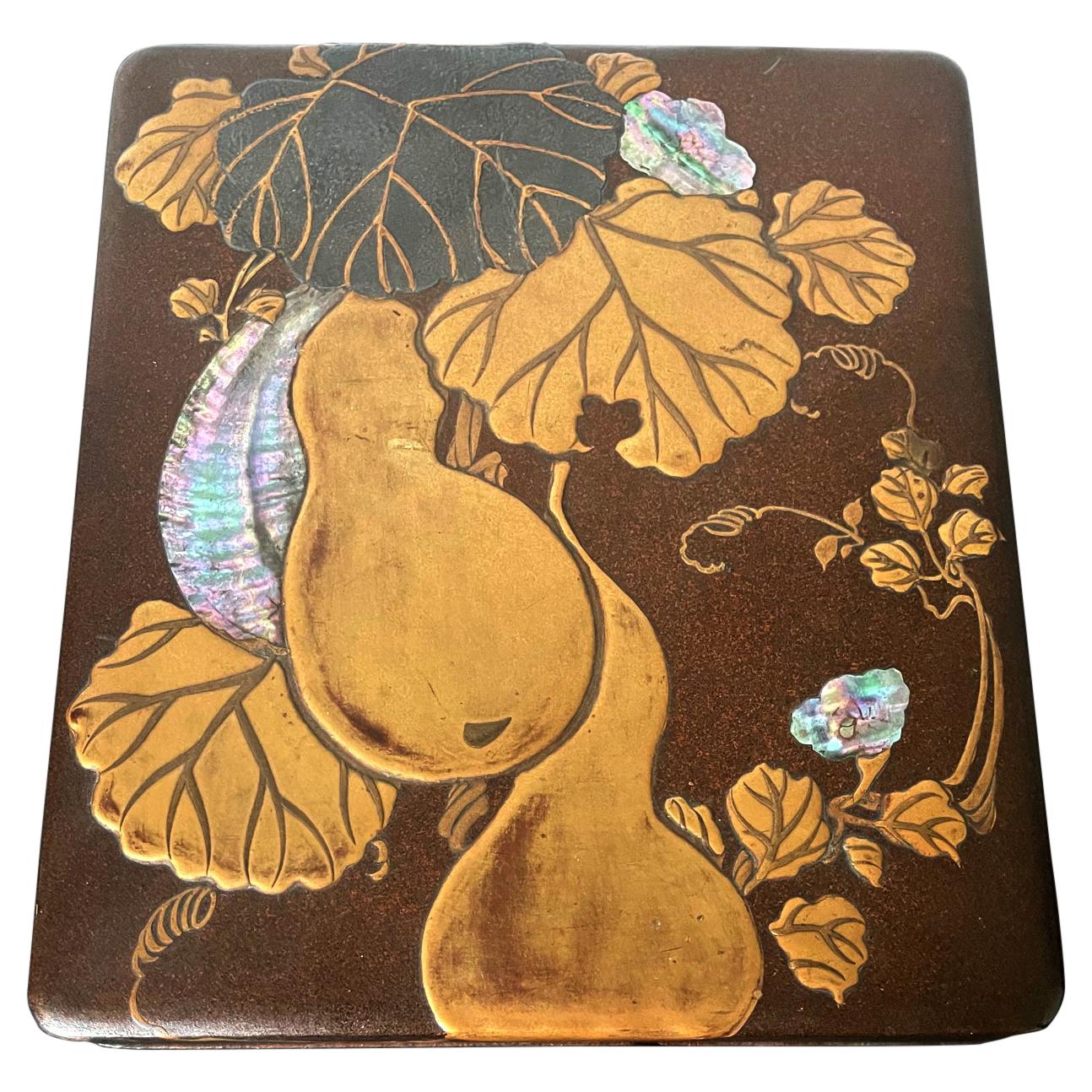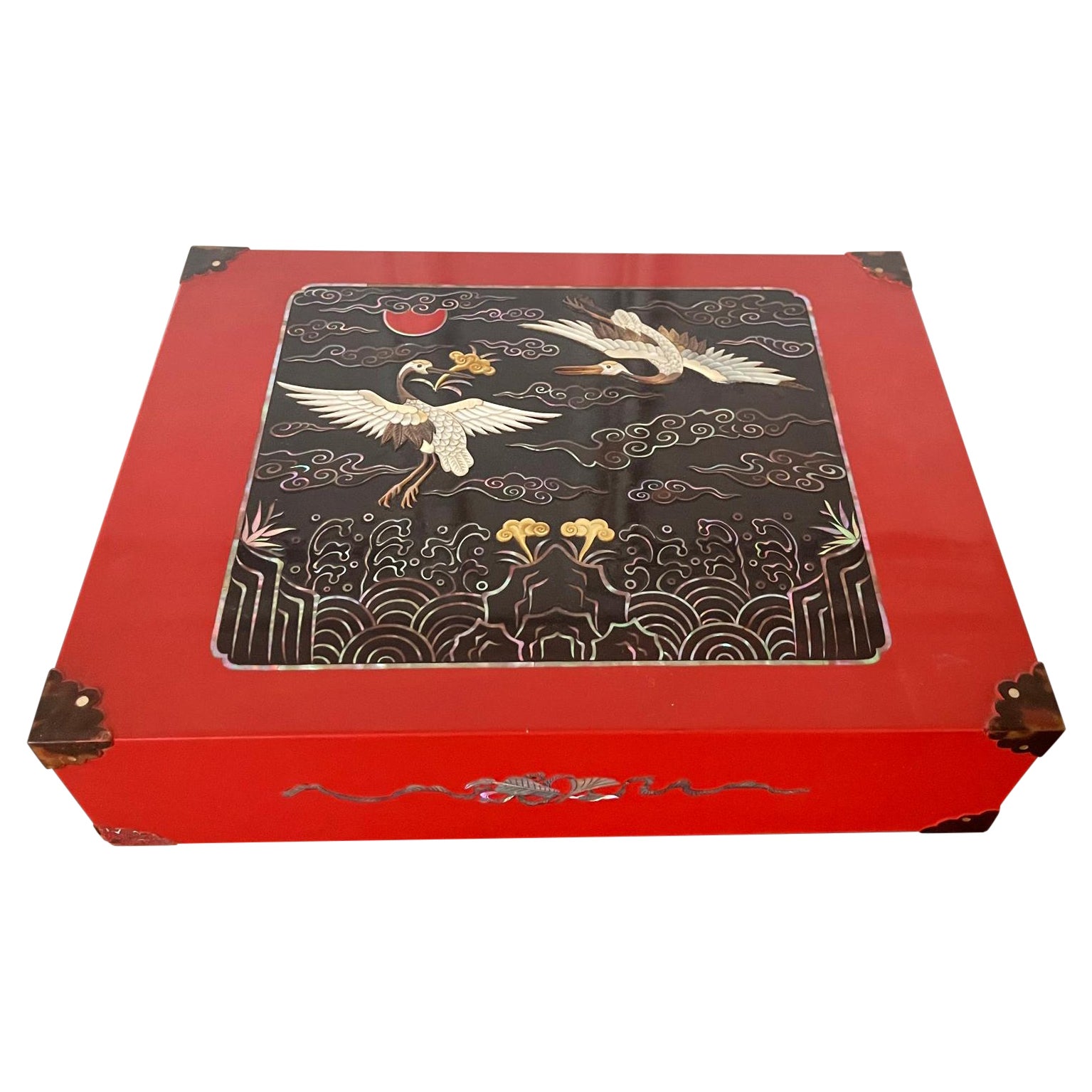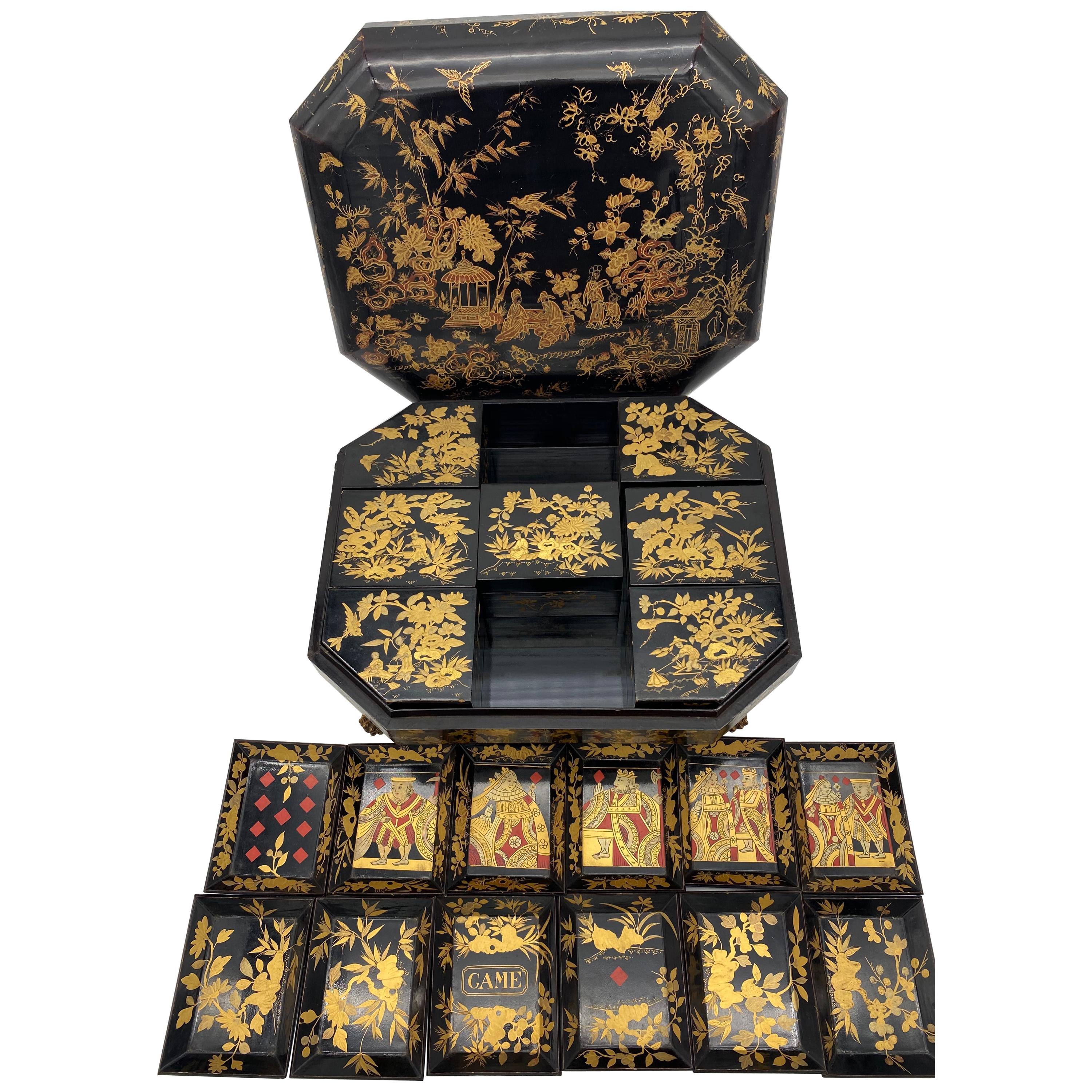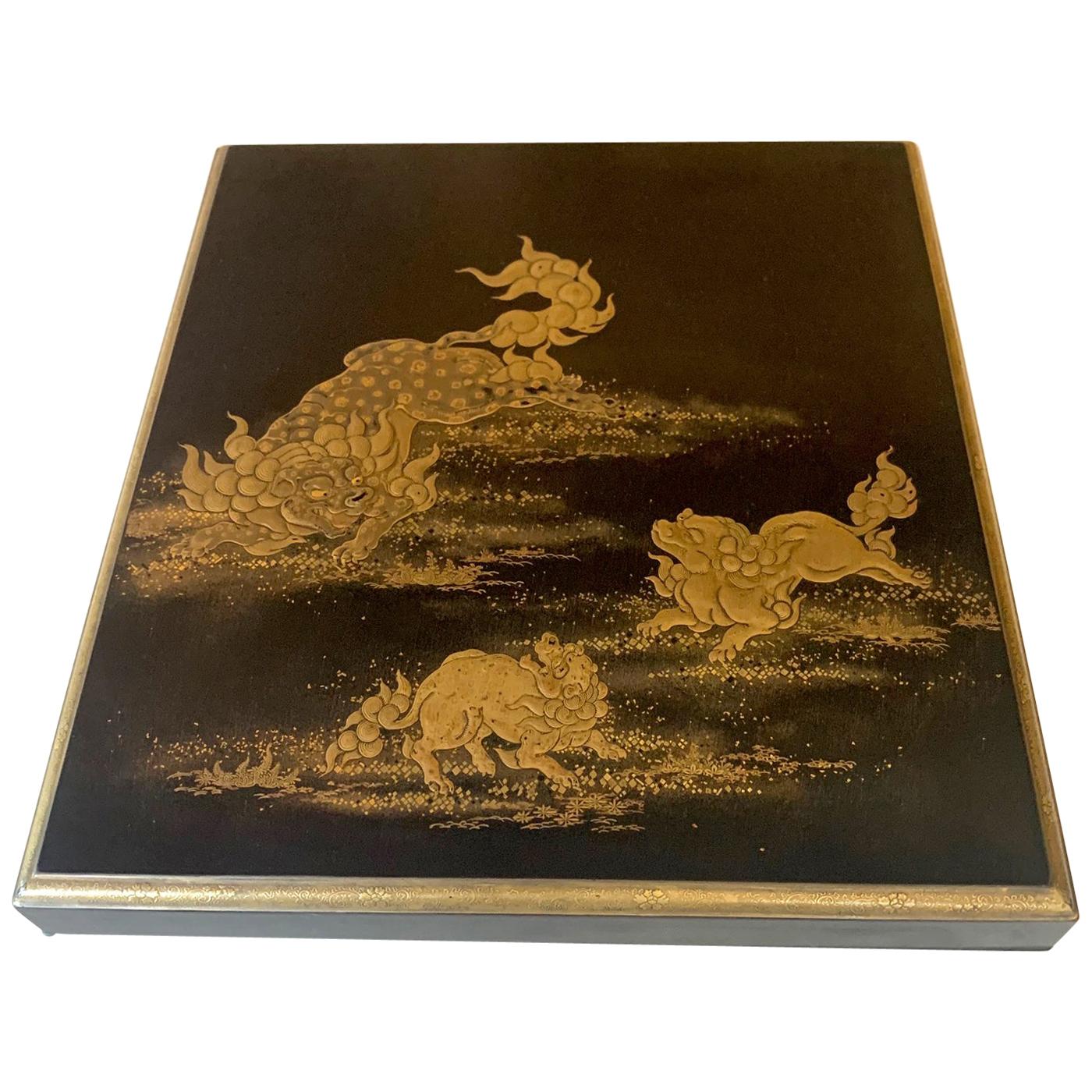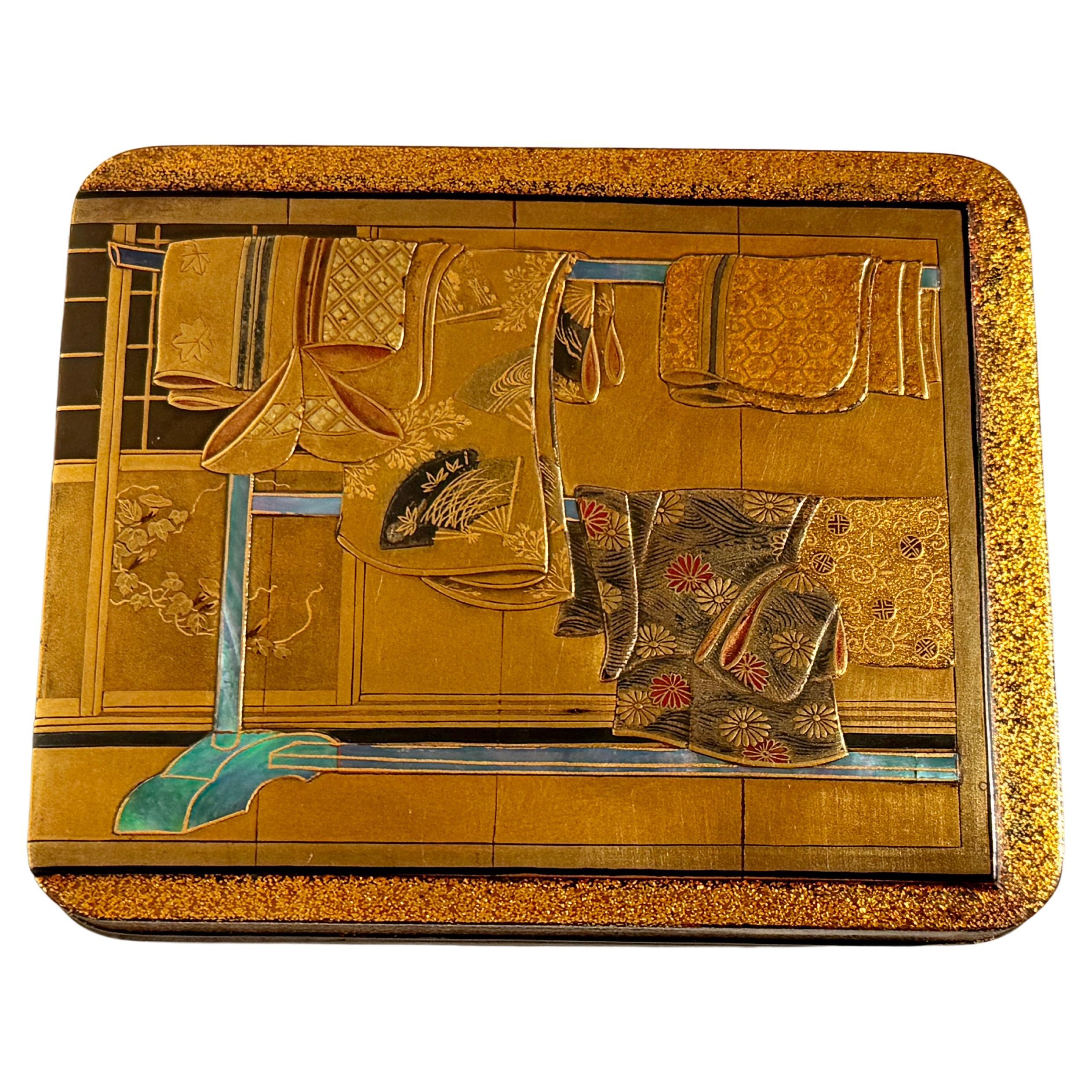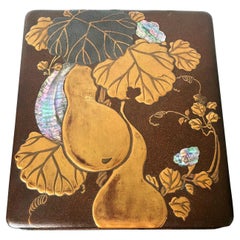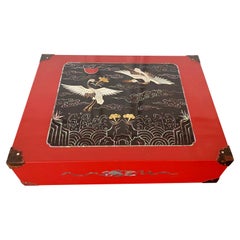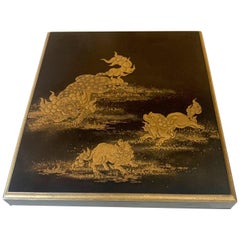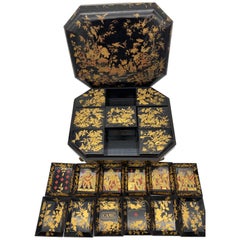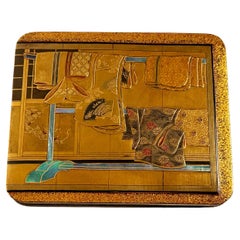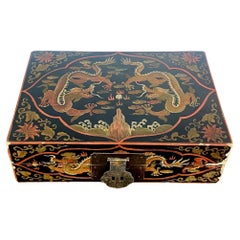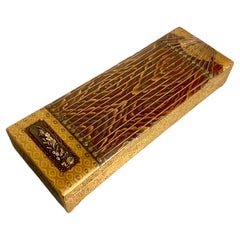Items Similar to Unusual Japanese Lacquer Inkstone Box with MOP Inlays
Want more images or videos?
Request additional images or videos from the seller
1 of 17
Unusual Japanese Lacquer Inkstone Box with MOP Inlays
$4,800
£3,644.08
€4,168.05
CA$6,706.30
A$7,458.87
CHF 3,894.79
MX$90,766.45
NOK 49,742.38
SEK 46,649.58
DKK 31,107.74
Shipping
Retrieving quote...The 1stDibs Promise:
Authenticity Guarantee,
Money-Back Guarantee,
24-Hour Cancellation
About the Item
A Japanese black lacquer box with mother of pearl inlays circa early 20th century, end of Meiji period. It was likely to be used to store inkstone or other scholarly items. The piece displays several interesting characteristics that appear puzzling initially. First, the form is not typical Japanese, but more Chinese and Korean, with its scalloped base. Second, the decoration of MOP inlays also suggests a Korean and Chinese affiliation, especially with the linear borders and the scrolling cloud patters on the sides of the box. These two observations suggest that the box may be from Ryukyu Island instead of Japanese mainland. Third, strikingly in the center of the cover, a bold quarterly floral pattern outlined with MOP was filled with a striking mottled red lacquer using tsugaru nuri technique. Tsugaru nuri was a pure Japanese invention from Aomori prefecture, centralized in Hirosaki city, dated to Edo period. Fourth, the particularity of the decoration using four dancing foxes (kitsunes) also indicates a Japanese origin. Kitsunes spirits permeate in a wide contexts in Japanese folklores and they could represent both the good and the tricky natures of the animal. More importantly, kitsunes were often used as motifs in Japanese decorative art, from painting, prints to lacquer ware (while it is less common to see them in Chinese and Korean art). These seemingly contradicting features point to a likelihood that the piece was made by an artist who created his unique style by combining the Ryukyu Island aesthetic with tsugaru nuri from Northern Japan and kitsunes motifs that were popular in Japanese art.
- Dimensions:Height: 3.4 in (8.64 cm)Width: 10 in (25.4 cm)Depth: 11.5 in (29.21 cm)
- Style:Japonisme (Of the Period)
- Materials and Techniques:
- Place of Origin:
- Period:
- Date of Manufacture:Early 20th Century
- Condition:Wear consistent with age and use. Minor losses. Stable age cracks on the corners, small dings and bumps along the edges, contact wear on the base. Because of the color, none is conspicuous to compromise the beauty of this piece. All as shown.
- Seller Location:Atlanta, GA
- Reference Number:1stDibs: LU945022333322
About the Seller
4.9
Platinum Seller
Premium sellers with a 4.7+ rating and 24-hour response times
Established in 2006
1stDibs seller since 2010
564 sales on 1stDibs
Typical response time: <1 hour
- ShippingRetrieving quote...Shipping from: Atlanta, GA
- Return Policy
Authenticity Guarantee
In the unlikely event there’s an issue with an item’s authenticity, contact us within 1 year for a full refund. DetailsMoney-Back Guarantee
If your item is not as described, is damaged in transit, or does not arrive, contact us within 7 days for a full refund. Details24-Hour Cancellation
You have a 24-hour grace period in which to reconsider your purchase, with no questions asked.Vetted Professional Sellers
Our world-class sellers must adhere to strict standards for service and quality, maintaining the integrity of our listings.Price-Match Guarantee
If you find that a seller listed the same item for a lower price elsewhere, we’ll match it.Trusted Global Delivery
Our best-in-class carrier network provides specialized shipping options worldwide, including custom delivery.More From This Seller
View AllAntique Japanese Lacquer and Inlay Box from Ryukyu Island
Located in Atlanta, GA
A lacquer presentation box with mother-of-pearl inlays from Japanese Ryukyu Islands circa 17-18th century. The lidded box in rectangular form with rounded corner is a classic example...
Category
Antique 18th Century Japanese Japonisme Lacquer
Materials
Mother-of-Pearl, Lacquer
Japanese Rinpa Style Lacquer Ink Stone Box Suzuribako
Located in Atlanta, GA
A Japanese writing box with ink stone (known as Suzuribako) with exquisite maki-e decoration circa late Meiji to early Taisho period (1890s-1930s)...
Category
Early 20th Century Japanese Japonisme Lacquer
Materials
Wood, Lacquer
Vintage Korean Lacquer Box with Inner Tray and MOP inlays
Located in Atlanta, GA
A lovely vintage Korean lacquer box in bright red and decorated with mother-of-pearl inlays circa 1970-80s. The square form box features an auspicio...
Category
Late 20th Century Korean Arts and Crafts Lacquer
Materials
Mother-of-Pearl, Lacquer
Japanese Lacquer Box with Fine Maki-e Decoration Meiji Period
Located in Atlanta, GA
A lacquered wood box with lid from Japan circa 19th century Meiji Period. The finely decorated box was used to store paper slips and small documents on the desk. It is overall finished with black lacquer (kuro) with sparse Mura-Nashiji effect outside and on the top surface of the lid, there are three Komainu, (sometimes known as Shishi or Japanese lions) frolicking and forming a circle in lively motion. Komainu are auspicious animals in Japanese cultures in both Shinto and Buddhism tradition. Originally from China, these animals symbolizes guardians to ward off evil spirits. Hiramaki-e was used in combination with carving and combing to render the lions with various surface textures. A gilt border with an slight angle was given to the lid and even the thin band is decorated with miniature floral scrolls. The interior of the box was finished in a dense nashiji. Underneath the lid, a cluster of peonies open lavishly by two gentle mounts. Takamaki-e (high relief) in both gold and silver were...
Category
Antique Late 19th Century Japanese Japonisme Lacquer
Materials
Wood, Lacquer
Japanese Rinpa Style Lacquer Box Meiji Period
Located in Atlanta, GA
A black lacquer tebako (hand box) with maki-e decoration and silver trim, circa late 19th century, Meiji period. The surface of the lid features a Rinpa style maki-e paint depicting ...
Category
Antique 1890s Japanese Japonisme Lacquer
Materials
Wood, Lacquer
Japanese Maki-e Lacquer Tray Box with Cutout Design
Located in Atlanta, GA
A Japanese lacquer box with lid and an inner tray decorated with Maki-e on a dense nashiji background. The fine box was likely made circa 1920-30s...
Category
Vintage 1920s Japanese Taisho Lacquer
Materials
Wood, Lacquer
You May Also Like
Antique 18th Century Export Chinese Lacquer Gaming Box
Located in Brea, CA
Antique 18th century export Chinese lacquer gaming box with hand painted scenes gilt export black lacquer, there are 7 gaming boxes and 12 trays, size: ...
Category
Antique Late 18th Century Chinese Qing Lacquer
Materials
Lacquer
Japanese Tagasode (Whose Sleeves?) Lacquer Incense Box, Kobako, Meiji Period
Located in Austin, TX
A fine and unusual Japanese lacquer box for incense accessories, kobako, featuring a tagasode (whose sleeves?) design, Meiji Period, circa 1900, Japan.
The exquisite box of simple rectangular shape worked in maki-e lacquer, taka-maki-e, and raden, all against a lush ground of gold nashiji. Fitted with silver rims.
The main decorative element of the box depicts a six panel folding screen, byobu, showing an interior scene with kimono strewn over a rack, a motif known as tagasode (whose sleeves), all in raised taka-maki-e lacquer and inlaid raden.
The screen depicts an intimate room with tatami mats on the floor and sliding shoji doors in the background. The foreground depicts a large clothing...
Category
Antique Early 1900s Japanese Meiji Lacquer
Materials
Silver
Chinese Black Lacquered Wood Box - Imperial Dragons - Ming Period Wanli 17th
Located in Beuzevillette, FR
Magnificent box Imperial jewelry box in black lacquered wood decorated with dragons.
This wonderful box is lacquered on a black background with patt...
Category
Antique 17th Century Chinese Ming Lacquer
Materials
Wood
Japanese Lacquer Writing Box, Suzuribako, Edo Period, 18th Century, Japan
Located in Austin, TX
An exceptionally fine and unusual Japanese lacquer writing implements box, suzuribako, in the form of a zither, koto, Edo Period, 18th century, Japan. With a modern wood storage box,...
Category
Antique 18th Century Japanese Edo Lacquer
Materials
Gold, Silver, Copper
Japanese Lacquer Hokai Box, 19th Century
Located in Pasadena, CA
This is a good example of a traditional Japanese Hokai shell storage box for the Kai-awase game. This box is well-detailed in chased brass appliques and makie. The box is in overall ...
Category
Antique Late 19th Century Japanese Japonisme Lacquer
Materials
Wood, Lacquer
$1,175 Sale Price
24% Off
Lacquered Japanese Writing Box, Mid 20th Century
Located in Jimbaran, Bali
A Lacquered Japanese writing box with metal detailing, mid 20th century. The box has signs of patina on the metal, a small crack in one corner and...
Category
Mid-20th Century Japanese Other Decorative Boxes
Materials
Wood
More Ways To Browse
Red Lacquer Furniture
Black And Red Lacquer
Unusual Items
Wood Inlay Art
Antique Lacquer Box
Antique Lacquer Boxes
Asian Red Lacquer
Antique Lacquer Painting
Red Lacquer Box
Japanese Red Lacquered
Black Lacquer Inlay
Japanese Lacquer Boxes
Japanese Lacquer Meiji
Fox Japanese
Black Lacquered Boxes
Japanese Inlay
Japan Edo Lacquer
Antique Chinese Lacquer Box
